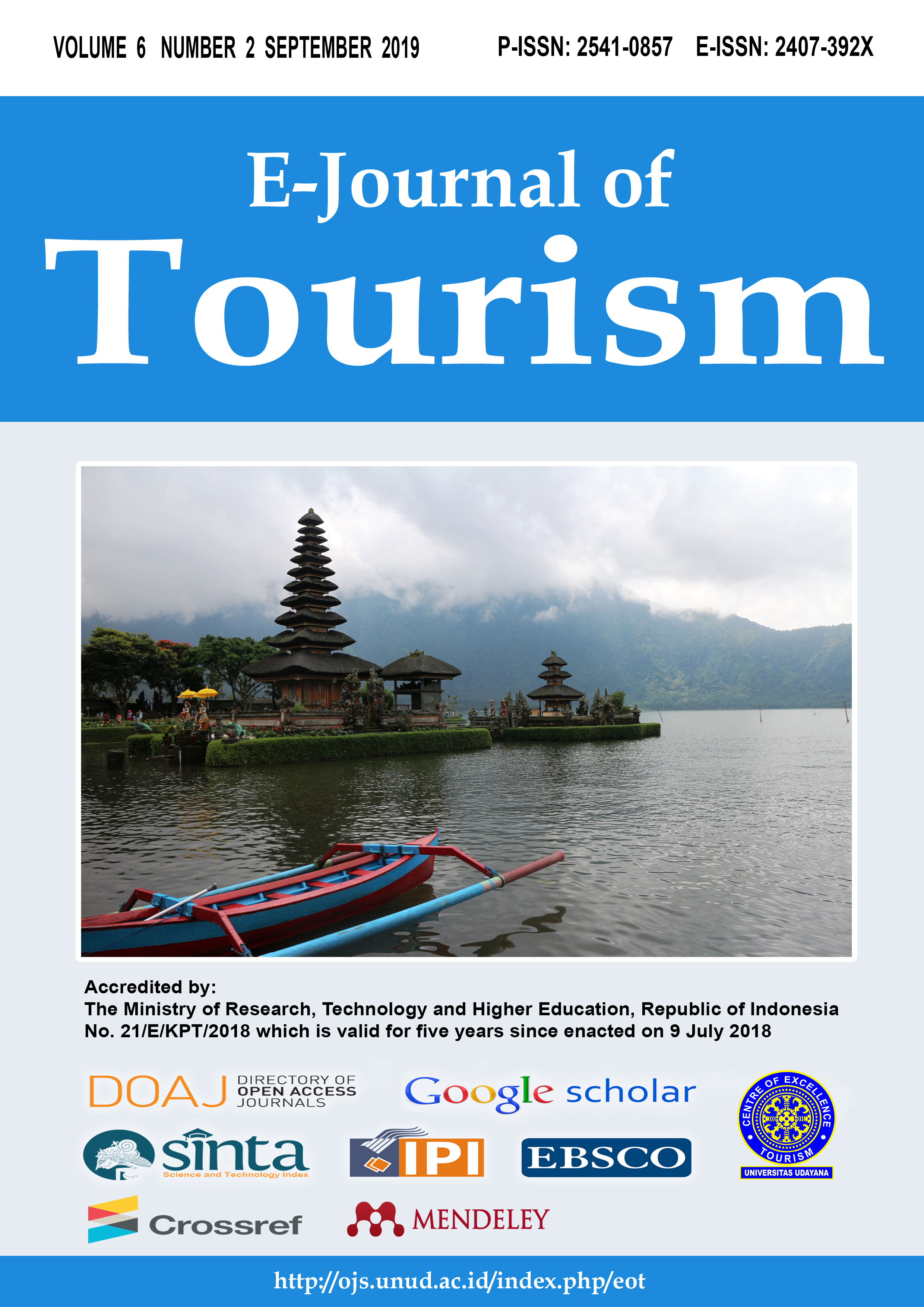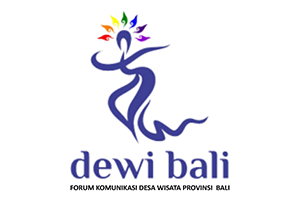Approaches to Indonesia Cultural Tourism Policy
Perspectives on The Cultural Tourism Governances in Bayan
Abstract
In support to the initiative of Indonesia government on the priority destinations project (ten new Bali) where Mandalika in Lombok Island is being endorsed as one of “New Bali” targeted development destination, the research is aimed to analyze the effective roles of national and regional government on the development of cultural tourism destination in Bayan Village, North Lombok administrative region, as it is one of the alternative tourist attractions in Lombok Island. For the purpose of objectivity, this research has limited the source and scope of the observation only from related stakeholders and Lombok local tourism government thus the research employed an in-depth interview through designated stakeholders clusters. The research examined and summarized the finding from the stakeholders’ perspectives that have either direct or indirect concerns toward Bayan Village’s development from which; a proposed recommendation on a tourism policy framework for the cultural destination was concluded. Based on our finding, the situation where the development initiated both by national and regional tourism government in Lombok did not show a fair distribution to all promising destinations especially Bayan Village in North Lombok as one of the cultural tourism assets in North Lombok.
Keywords: Cultural tourism destination, cultural tourism governance, tourism policy, stakeholder perspectives.
Downloads
References
Andereck, L., Valentine, M., Knopf, C. & Vogt, A. (2005).Resident’s perceptions of community tourism impacts. Annals of Tourism Research, 32(4), 1056-1076.
Benchkendorff, P., & Zehrer, A. (2003). A network Analysis of Tourism Research. Annals of Tourism Research, 43: 121-149
Bramwell, B. (2014). Local Participation in Community Tourism. A Critical and Relational Assessment’ in Alan Lew, C. Michael Hall & Allan Williams (eds), The Wiley Blackwell Companion to Tourism, John Wiley & Sons, Chichester.
Carmin,J., Darnall, N.& Mil-Homens, J.(2003). Stakeholder involvement in the design of U.S. voluntary environment programs: Does sponsorship matter? Policy Studies Journal, 31(4), 527-543.
Church, A. (2004). Local and Regional Tourism Policy and Power’ in Alan Lew, C. Michael Hall & Allan Williams (eds) (2007), A Companion to Tourism, Blackwell, Oxford.
Clarkson, M. (1995). A stakeholder framework for analyzing and evaluation corporate social performance. The Academy of Management Review, 20 (1), 92-117.
Coles, T., & Hall, M. (2011). Rights and Regulation of Travel and Tourism Mobility. Journal of Research in Tourism, Leisure and Events, 5:1-27.
Curry, N. (2001). Community participation and rural policy: representative ness in the development of Millennium Greens. Journal of Environmental Planning and Management Forum, 46, 170-178.
Davis, S. & Morais, P. (2004). Factions and enclaves: small towns and socially unsustainable tourism development. Journal of Travel Research, 43, 3-10.
De Lopez,T. (2001). Stakeholder management for conservation projects: a case study of Ream National Park, Cambodia, Environmental Management, 28 (1), 47-60.
Devine, A., & Devine, F. (2011). Planning and Developing Tourism within a Public Sector Quagmire: Lessons from and for small countries: Tourism Management., 32: 1253-1261.
Donaldson, T. & Preston, L. (1995). The stakeholder theory of the corporation: Concepts, evidence, and implications. The Academy of Management Review, 20 (1), 65-91.
Dredge, D., & Jenkins, J. (2003). Federal-state Relations and Tourism Public Policy, New South Wales, Australia: Current Issues in Tourism, 6: 415-443.
Dredge, D. (2006). Policy Networks and the Local Organization of Tourism: Tourism Management, 27: 269-280.
Dredge, D., & Jenkins, J. (2012). Australian National Tourism Policy: Influences of Reflective and Political Modernisation. Tourism Planning & Development, 9: 231-251.
Freeman, E. (1984). Strategic management: A stakeholder approach. Toronto: Pitman.
Goeldner, R. & Ritchie, B. (2003). Tourism: Principles, Practices, Philosophies. Hokoben, NJ. John Wiley & Sons, Inc.
Gonzales, S. (2011), Bilbao and Barcelona “in motion”. How Urban Rgeneration “models” Travel and Mutate in the Global Flow of Policy Tourism: Urban Studies, 48: 1397-1418.
Gun, A. (1994). Tourism Planning: Basic Concept Cases. Taylor and Francis, Washington D.C.
Gursoy, D., Jurowski, C. & Uysal, M. (2002). Resident attitudes: A structural modeling approach. Annals of Tourism Research, 29 (1), 79-105.
Halkier, H. (2010). EU and Tourism Development: Bark or Bite? Scandinavian Journal of Hospitality and Tourism, 10: 92-106.
Hall, C. M. (2008). Tourism Planning, 2nd Edition: Pearson, Harlow.
Hall, C. M. (2011b). A Typology of Governance and its Implications for Tourism Policy Analysis; Journal of Sustainable Tourism, 19: 437-457.
Heeley, J. (2011). Public: Private Partnership and Best Practice in Urban Destination Marketing: Tourism and Hospitality Rsearch, 11: 224-229.
Holloway, J. C. (1998). The Business of Tourism. New York. Longman.
Jerkins, J., & Stolk, P. (2003). Statutory Authoroties Dancing with Enterprise: WA Inc., the Western Australian Tourism Commission and the “global dancer affair’: Annals of Leisure Research, 6: 222-244.
Jenkins, J., Hall, M., & Mkono, M. (2014). Tourism and Public Policy: Contemporary Debates and Future Directions’ in Alan Lew, C. Michael Hall 7 allan Williamns (eds), The Wiley Blackwell Companion to Tourism, John Wiley & son, Chichester.
Jordan, E J., Vogt, C. A., Kruger, L.E., Grewe, N. (2013). The Interplay of Governance, Power and Citizen Participation in Community Tourism Planning: Journal of Policy Research in Tourism, Leisure and Events, 5: 270-288.
Kernnell, J., & Chaperon, S. (2013). Analysis of the UK Government’s 2011 Tourism Policy. Cultural Trends, 22: 278-284.
Kerr, W. R. (2003). Tourism Public Policy, and the Strategic Management of Failure. An Imprint of Elsevier Science. Alloway, U.K. Pergamon.
Map of Gunung Rinjani National Park. Retrieved on December 2, 2017 from www.site.google.com
Richards, G. (1996). Cultural Tourism in Europe. Wellingford: CABI.
Richards, G. (2001a). The Development of Cultural Tourism in Europe, in Richads, G. (ed.) Cutural Attractions and European Tourism, Wallingford: CABI, pp. 11-35.
Sabatier, P. A. (1999). Theories of the Policy Process, Theoretical Lenses on Public Policy. Boulder, Colorado. Westview Press.
Smith K. M. (2003). Issues in Cultural Tourism Studies. Rouletge, New York.
Steelman, A. (2001). Elite and participatory policy-making: Finding balance in a case of national forest planning. Policy Studies Journal, 29 (1), 71-89.
Svensson, B. (2005). A Governance Perspective on Destination Development: Exploring Partnership, Clusters and Innovation System: Tourism Review, 60: 32-37.
Yuksel, F., Bramwell, B. &Yuksel, A. (1999). Stakeholder interviews and tourism planning at Pamukkale, Turkey.Tourism Management, 20, 351-360.
Zapata, M. J. (2014). Community Impacts, Partnerships and Tourism People’ in Alan Lew, C. Michael Hall & Allan Williams (eds), The Wiley Blackwell Companion to Tourism, John Wiley & Sons, Chichester.
Zeppel, H. and Hall, C. M. (1992). Arts and Heritage Tourism, in Weiler, B. and Hall, C.M. (eds0 Special Interest Tourism, London: Belhaven Press, pp. 47-65.

This work is licensed under a Creative Commons Attribution 4.0 International License.
The copyright of the received article shall be assigned to the journal as the publisher of the journal. The intended copyright includes the right to publish the article in various forms (including reprints). The journal maintains the publishing rights to the published articles.




















